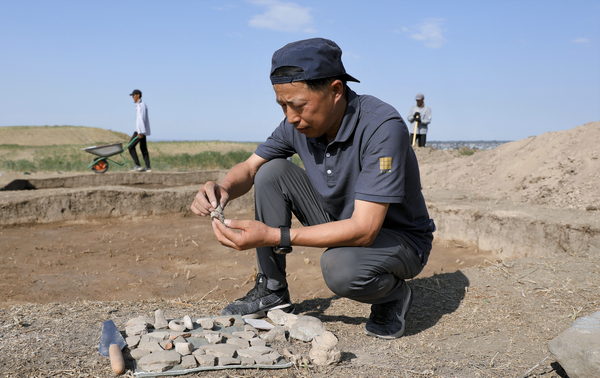

In recent years, a number of Chinese scholars have set out from Xi'an to explore the cultural relics of the ancient Silk Road, together with scholars from countries involved in the Belt and Road Initiative.
Wang began his archaeological and research work on the ancient Silk Road at the end of the last century. After 10 years of excavation and research on the Silk Road in China, he felt an urgent desire to do the same overseas.
"Only by mastering more comprehensive firsthand information can Chinese scholars bring a 'Chinese voice' to the international archaeology community," says Wang.
Zhang traveled to Central Asia in search of the ancient nomads called the Greater Yuezhi, who had migrated west after being defeated by the Xiongnu people.
Since 2009, Wang has followed in Zhang's footsteps, leading an archaeological team from Northwest University to Uzbekistan to carry out joint archaeological work along the Silk Road.
For more than 10 years, Wang's team has been conducting explorations in Central Asia, and has formed an archaeological team with professionals from Uzbekistan. They have made a series of finds, including a batch of settlements of ancient nomadic and agricultural cultures in the western Tianshan Mountains.
At the Rahat site, the archaeological work carried out by Chinese and Kazakh scholars has also yielded fruitful results. Since 2017, the Shaanxi Academy of Archaeology and the Issyk State Historical and Cultural Reserve-Museum have formed a joint team to carry out archaeological investigations and excavations at the site and at others nearby.
Archaeologists from China and Kazakhstan first conducted investigations and trial excavations at the Rahat site, and then cleaned up and excavated the remains of tombs, ash pits and ditches, unearthing a large number of relics, including ironware, stone tools and pottery pieces.
Gulmira Mukhtarova, director of the Issyk State Historical and Cultural Reserve-Museum, has also been participating in the work at the Rahat site. "From the unearthed relics, we can observe the traces of people's lives along the ancient Silk Road, which will help us study the site in depth and make an important contribution to the historical research in this area," says Mukhtarova.
The flow of expertise is not all in one direction, according to Mukhtarova. Eight Kazakh scholars have traveled to China to participate in archaeological excavations and exchange experiences there.
In April, the General Assembly of the Alliance for Cultural Heritage in Asia was held in Xi'an. A joint declaration on cultural heritage protection in Asia was issued at the assembly. According to the declaration, alliance members will carry out collaborative archaeological projects on themes such as the origins of civilizations and the Silk Road, and make a joint declaration on world heritage.
Also in Xi'an, China and five Central Asian countries reached a series of agreements on cooperation at the China-Central Asia Summit held in May, including cooperation in conducting joint archaeological and cultural heritage protection and restoration.
The cooperation has not only yielded fruitful results in terms of archaeology, but has also fostered goodwill and enthusiasm that has been appreciated by Chinese archaeologists working overseas. "People say nihao (hello in Chinese) and smile at us, and government officials give the thumbs-up sign to archaeological experts from China," says Wang.
"The joint archaeological work carried out within the framework of the Belt and Road Initiative is of great significance," says Mukhtarova. "The Chinese and Kazakh archaeologists have learned from each other in our excavation practice, resulting in a successful experience for Belt and Road people-to-people exchange."